-
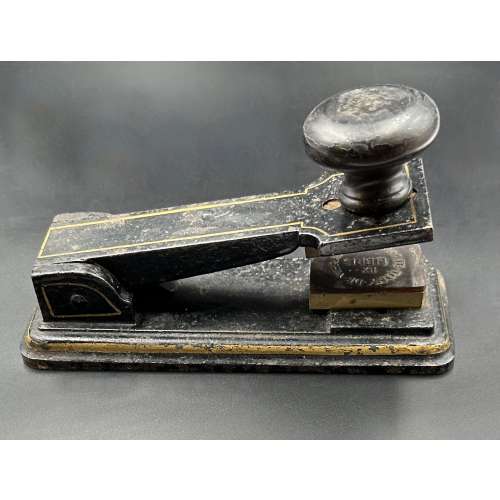 Iron pliers painted black and outlined in gilt lacquer, with wooden handle and bronze seals, "Ex Libris Comte Tony de Vibraye", L17.1 x W6.9 x H7.5 cm. Provenance: Antoine Henri Gaston Hurault de Vibraye [Comte Tony de Vibraye] (French, 1893 – 1951). The book with such a stamp in this library: [LIB-3243.2023] Crébillon fils. La Nuit et le moment ou Les Matinées de Cythère / Illustrations de Sylvain Sauvage. — Paris: Au dépens d’un amateur, 1924.
Iron pliers painted black and outlined in gilt lacquer, with wooden handle and bronze seals, "Ex Libris Comte Tony de Vibraye", L17.1 x W6.9 x H7.5 cm. Provenance: Antoine Henri Gaston Hurault de Vibraye [Comte Tony de Vibraye] (French, 1893 – 1951). The book with such a stamp in this library: [LIB-3243.2023] Crébillon fils. La Nuit et le moment ou Les Matinées de Cythère / Illustrations de Sylvain Sauvage. — Paris: Au dépens d’un amateur, 1924. -
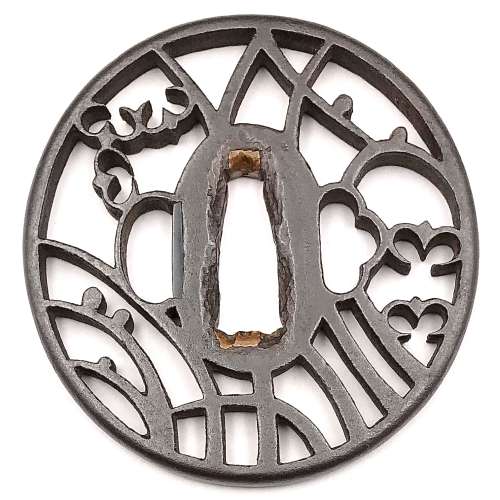 Iron tsuba of slightly elongated round form with design of wild geese and drops on pampas grass (masashino) in openwork (sukashi). Rounded rim. Copper sekigane. Owari school. Early Edo period: early 17th century (Kan-ei era). Height: 78.8 mm. Width: 76.3 mm. Rim thickness: 6.1 mm. Center thickness: 6.4 mm. Provenance: Sasano Masayuki Collection, № 169. A description of musashino symbolism can be found at Symbols of Japan by Merrily Baird [Merrily Baird. Symbols of Japan. Thematic motifs in art and design. Rizzoli international publications, Inc., 2001]: Musashino - "the plain of Musashi - a large expanse in the Tokyo area, was celebrated in poetry for the grasses that grew there before the recent era of industrialization... The use of Musashino themes was particularly common in the Momoyama and Edo periods". Pampas grass with dew drops and wild geese in flight collectively provide strong autumnal connotation.
Iron tsuba of slightly elongated round form with design of wild geese and drops on pampas grass (masashino) in openwork (sukashi). Rounded rim. Copper sekigane. Owari school. Early Edo period: early 17th century (Kan-ei era). Height: 78.8 mm. Width: 76.3 mm. Rim thickness: 6.1 mm. Center thickness: 6.4 mm. Provenance: Sasano Masayuki Collection, № 169. A description of musashino symbolism can be found at Symbols of Japan by Merrily Baird [Merrily Baird. Symbols of Japan. Thematic motifs in art and design. Rizzoli international publications, Inc., 2001]: Musashino - "the plain of Musashi - a large expanse in the Tokyo area, was celebrated in poetry for the grasses that grew there before the recent era of industrialization... The use of Musashino themes was particularly common in the Momoyama and Edo periods". Pampas grass with dew drops and wild geese in flight collectively provide strong autumnal connotation. -
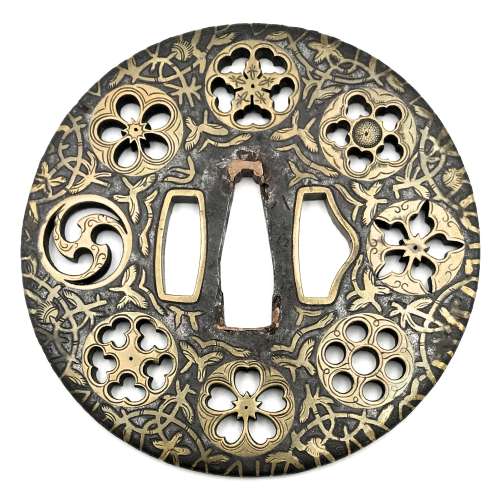 Well-forged iron plate of round shape (maru-gata) is decorated with water weeds or arabesque (karakusa) in flat brass inlay (hira-zōgan) all over and eight family crests (mon) of round form in cast brass with delicate linear carving (kebori) and openwork (sukashi). Crests represent: [at 9 hours] three counter-clockwise commas or swirls (tomoe); [at 10:30] plum blossom (ume); [at 12:00, 1:130, and 7:30] - stylized flower made by cutting out five suhama symblos (flower-shaped suhama); [at 3:00] bellflower (kikyō); [at 4:30] seven-star crest (shichiyō-mon); [at 6:00] cherry blossom (sakura). Brass-trimmed ryo-hitsu. Copper sekigane. Yoshirō school. Momoyama or early Edo period, end of the 16th to first half of the 17th century (1574-1650). Inscription on seppa-dai: 八幡 - Hachiman. Size: height 89.6 mm, width 89.3 mm, thickness at seppa-dai 3,0 mm. Weight 129.7 g. NBTHK certificate № 4007685, June 27, 2015: HOZON (Worthy of Preservation). As for the inscription, Nihonto Message Board blog discussion provides the following explanation of the inscription: "An expression of conviction as to being the best under the sun". On the other hand, there may be more in this confluence of symbols: the tomoe crest at 9:00 is "the kamon of Hachiman, the war god" [Family Crests of Japan; Stone Bridge Press, Berkeley, CA, 2007, p. 108]. The character 八 in the inscription cut stronger than the other kanji, and may be by a different hand in different time. 八 (hachi, eight): "The numeral eight was appreciated because its shape broadens toward the bottom, symbolizing eternal expansion" [ibid, p. 119]. It may be said that this tsuba is dedicated to Hachiman. Other crests (suhama, bellflower, seven-stars, plum and cherry blossoms) collectively allude to "good old times" when Fijiwara and Taira clans were in full bloom. Markus Sesko believes that the inscriptions reads: Hachiman: "the inscription is/was HACHIMAN (八幡), the God of War and a relatively popular inscription for tsuba, swords and armor." Elliott Long and Robert Haynes provide the following explanation of the inscription: "...hachi is correct and represents the name of the HACHI SHRINE. The inscription reads 'YAWATA' which is the name of the mountain in Mino Province where the HACHI Shrine is located". Details on Hachiman Shrine in Yawata (八幡市) can be found elsewhere, including Historical and geographical dictionary of Japan by Edmond Papinot. Van Ham auction house provides the following description: MON-SUKASHI TSUBA. MARUGATA. Japan. Momoyama period. Yoshiro school. Iron with inlays of brass. In hira-zogan technique with kebori engraving eight different family emblems (mon). An old inscription is dedicated to the deity Hachiman. D.4.5mm, Ø 8.3cm. Condition A/B. Supplement: Wooden box and NBTHK certificate.
Well-forged iron plate of round shape (maru-gata) is decorated with water weeds or arabesque (karakusa) in flat brass inlay (hira-zōgan) all over and eight family crests (mon) of round form in cast brass with delicate linear carving (kebori) and openwork (sukashi). Crests represent: [at 9 hours] three counter-clockwise commas or swirls (tomoe); [at 10:30] plum blossom (ume); [at 12:00, 1:130, and 7:30] - stylized flower made by cutting out five suhama symblos (flower-shaped suhama); [at 3:00] bellflower (kikyō); [at 4:30] seven-star crest (shichiyō-mon); [at 6:00] cherry blossom (sakura). Brass-trimmed ryo-hitsu. Copper sekigane. Yoshirō school. Momoyama or early Edo period, end of the 16th to first half of the 17th century (1574-1650). Inscription on seppa-dai: 八幡 - Hachiman. Size: height 89.6 mm, width 89.3 mm, thickness at seppa-dai 3,0 mm. Weight 129.7 g. NBTHK certificate № 4007685, June 27, 2015: HOZON (Worthy of Preservation). As for the inscription, Nihonto Message Board blog discussion provides the following explanation of the inscription: "An expression of conviction as to being the best under the sun". On the other hand, there may be more in this confluence of symbols: the tomoe crest at 9:00 is "the kamon of Hachiman, the war god" [Family Crests of Japan; Stone Bridge Press, Berkeley, CA, 2007, p. 108]. The character 八 in the inscription cut stronger than the other kanji, and may be by a different hand in different time. 八 (hachi, eight): "The numeral eight was appreciated because its shape broadens toward the bottom, symbolizing eternal expansion" [ibid, p. 119]. It may be said that this tsuba is dedicated to Hachiman. Other crests (suhama, bellflower, seven-stars, plum and cherry blossoms) collectively allude to "good old times" when Fijiwara and Taira clans were in full bloom. Markus Sesko believes that the inscriptions reads: Hachiman: "the inscription is/was HACHIMAN (八幡), the God of War and a relatively popular inscription for tsuba, swords and armor." Elliott Long and Robert Haynes provide the following explanation of the inscription: "...hachi is correct and represents the name of the HACHI SHRINE. The inscription reads 'YAWATA' which is the name of the mountain in Mino Province where the HACHI Shrine is located". Details on Hachiman Shrine in Yawata (八幡市) can be found elsewhere, including Historical and geographical dictionary of Japan by Edmond Papinot. Van Ham auction house provides the following description: MON-SUKASHI TSUBA. MARUGATA. Japan. Momoyama period. Yoshiro school. Iron with inlays of brass. In hira-zogan technique with kebori engraving eight different family emblems (mon). An old inscription is dedicated to the deity Hachiman. D.4.5mm, Ø 8.3cm. Condition A/B. Supplement: Wooden box and NBTHK certificate. -
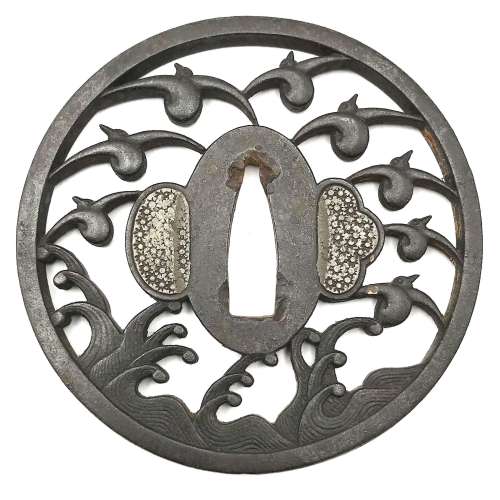
Iron tsuba of circular form with the knotted geese (kari) flying over the rough waves pierced (sukashi) and carved in low relief (nikubori). Hitsu-ana plugged with soft metal. Hitsu-ana plugged with soft metal (tin or lead).
Signed: Echizen koku jū Myochin Katsuharu saku.
Edo period.Size: Height: 80.7 mm; Width: 81.0 mm; Thickness: 4.5 mm; Weight: 110 g.
Two tsuba of this master can be found at Georg Oeder Collection (Japanische Stichblätter und Schwertzieraten. Sammlung Georg Oeder Düsseldorf. Beschreibendes Verzeichnis von P. Vautier. Herausgegeben von Otto Kümmel.Oesterheld & Co / Verlag / Berlin, Oesterheld, 1915; LIB-1465 in this collection) under №№ 172 and 173, page 21, though no illustrations. SOLD. -
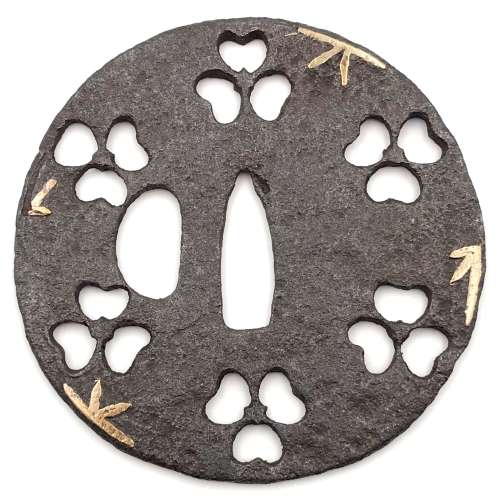
Thin iron tsuba of round form pierced with six three-leaf wood sorrels (katabami) in ko-sukashi and inlaid with brass decoration along the rim. Kozuka-hitsu-ana probably cut at a later date.
Late Muromachi or Momoyama period, 16th century. Dimensions: 78.0 x 77.7 x 2.5 mm. -
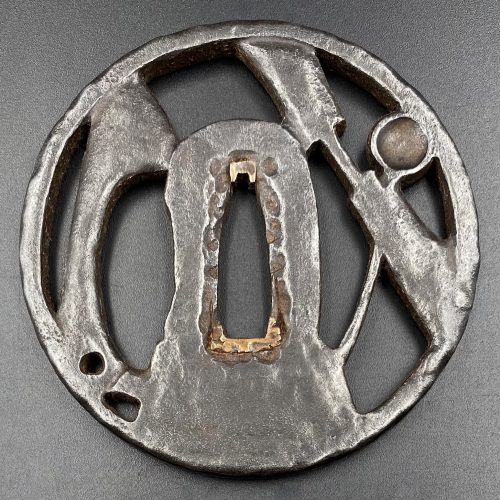 Iron tsuba of round form decorated with a ladle, pestle, mortar, and rice sickle in positive silhouette openwork (nikubori-ji-sukashi). Slightly rounded rim with iron bones (tekkotsu). Seppa-dai plugged with copper fittings (sekigane). Silver patina. The design resembles mochi-making utensils; mochi (rice cake) symbolizes longevity. Kanayama school, c. 1590 (Momoyama period). Note: unusually large size for a Kanayama tsuba: diameter 79.5 mm, thickness at seppa-dai: 5.5 mm, at rim: 6.0 mm. Concerning the design: While the ladle and pestle are clear, the mortar (under the seppa-dai), and the sickle (to the left) require certain imagination.
Iron tsuba of round form decorated with a ladle, pestle, mortar, and rice sickle in positive silhouette openwork (nikubori-ji-sukashi). Slightly rounded rim with iron bones (tekkotsu). Seppa-dai plugged with copper fittings (sekigane). Silver patina. The design resembles mochi-making utensils; mochi (rice cake) symbolizes longevity. Kanayama school, c. 1590 (Momoyama period). Note: unusually large size for a Kanayama tsuba: diameter 79.5 mm, thickness at seppa-dai: 5.5 mm, at rim: 6.0 mm. Concerning the design: While the ladle and pestle are clear, the mortar (under the seppa-dai), and the sickle (to the left) require certain imagination. -
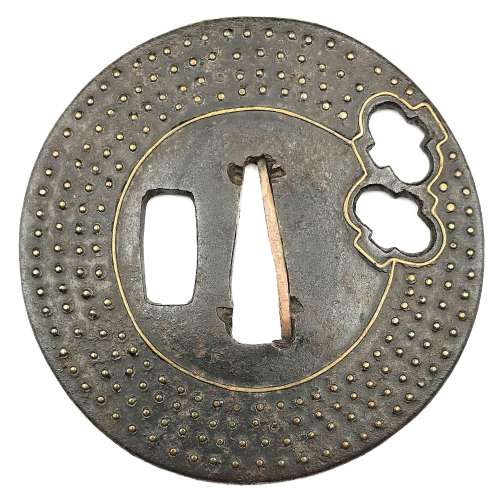 Iron tsuba of round form with design of two paper lanterns in openwork (small cut-outs, ko-sukashi ) outlined with brass wire. The plate is decorated with four concentric rows of brass dot inlay (ten-zōgan), with a brass circular wire inside the innermost row of dots (missing on the back). Hitsu-ana of rectangular form is not outlined with brass wire, which let us suppose that it was cut out at a later date. Copper sekigane. Mid Muromachi period (1454-1513). Diameter: 74.0 mm, thickness: 2.6 mm. Tsuba is illustrated at: 新版 日本刀講座 小道具鑑定編 本間 薫山 佐藤 寒山 : Shinhan Nihonto Koza, Volume VI, Kodogu Part 1. Under supervision of Honma Kunzan and Sato Kanzan. 鍔 無名 応仁 鉄地) 丸形 小透 槌目 真鍮据文 点象嵌 丸耳 : Tsuba with no signature, Ōnin style. Base metal iron (jigane), round shape, small perforations (ko-sukashi), hammering finish (tsuchime). Pre-cast brass inlay (shinchu suemon-zōgan); dot inlay (ten-zōgan); round edge (maru-mimi).
Iron tsuba of round form with design of two paper lanterns in openwork (small cut-outs, ko-sukashi ) outlined with brass wire. The plate is decorated with four concentric rows of brass dot inlay (ten-zōgan), with a brass circular wire inside the innermost row of dots (missing on the back). Hitsu-ana of rectangular form is not outlined with brass wire, which let us suppose that it was cut out at a later date. Copper sekigane. Mid Muromachi period (1454-1513). Diameter: 74.0 mm, thickness: 2.6 mm. Tsuba is illustrated at: 新版 日本刀講座 小道具鑑定編 本間 薫山 佐藤 寒山 : Shinhan Nihonto Koza, Volume VI, Kodogu Part 1. Under supervision of Honma Kunzan and Sato Kanzan. 鍔 無名 応仁 鉄地) 丸形 小透 槌目 真鍮据文 点象嵌 丸耳 : Tsuba with no signature, Ōnin style. Base metal iron (jigane), round shape, small perforations (ko-sukashi), hammering finish (tsuchime). Pre-cast brass inlay (shinchu suemon-zōgan); dot inlay (ten-zōgan); round edge (maru-mimi).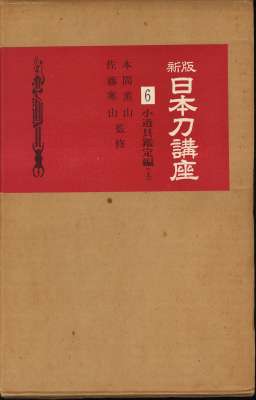
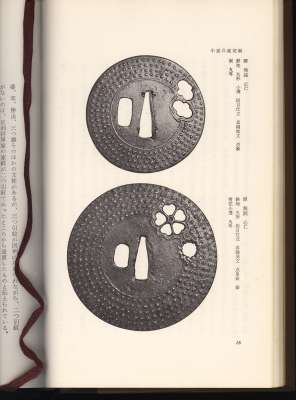 English translation of the book indicated above Nihon Tō Kōza, Volume VI, Part 1 by Harry Afu Watson, AFU Research Enterprises, Inc., 1993. Tsuba in question illustrated on page 14 and described as follows: " Tsuba mumei Ōnin. Tetsu ji maru gata ko-sukashi tsuchime shitate shinchū suemon ten zogan maru mimi. Brass suemon". My question remains: why such a text is called 'translation' while it looks more like transliteration of romanization?
English translation of the book indicated above Nihon Tō Kōza, Volume VI, Part 1 by Harry Afu Watson, AFU Research Enterprises, Inc., 1993. Tsuba in question illustrated on page 14 and described as follows: " Tsuba mumei Ōnin. Tetsu ji maru gata ko-sukashi tsuchime shitate shinchū suemon ten zogan maru mimi. Brass suemon". My question remains: why such a text is called 'translation' while it looks more like transliteration of romanization? -
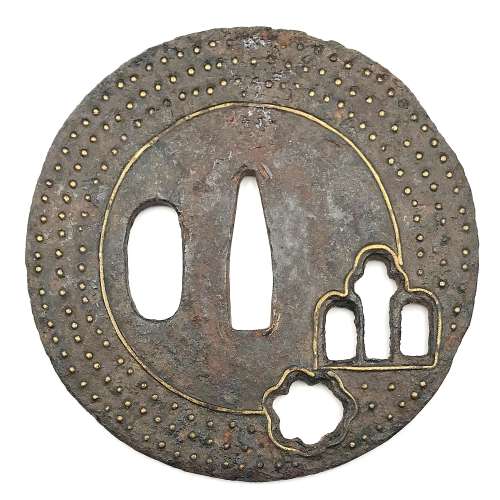 Iron tsuba of round form with design of iris and snowflake in openwork (ko-sukashi or small cut-outs) outlined with brass wire. Three concentric rows of brass dots (ten-zōgan), with a brass circular line inside the innermost row of dots (missing on the back). Hitsu-ana is not outlined with brass wire, which let us suppose that it was cut out at a later date. Iron and brass. Ko-sukashi and ten-zōgan technique. Mid Muromachi period (1454-1513). Height: 74.0 mm, Width: 73.6 mm, Thickness: 3.0 mm.
Iron tsuba of round form with design of iris and snowflake in openwork (ko-sukashi or small cut-outs) outlined with brass wire. Three concentric rows of brass dots (ten-zōgan), with a brass circular line inside the innermost row of dots (missing on the back). Hitsu-ana is not outlined with brass wire, which let us suppose that it was cut out at a later date. Iron and brass. Ko-sukashi and ten-zōgan technique. Mid Muromachi period (1454-1513). Height: 74.0 mm, Width: 73.6 mm, Thickness: 3.0 mm.NBTHK certification of 1968: "Kicho". Condition is relatively poor: rust, missing inlay, scratches.
While representation of the snowflake is rather standard, the meaning of the other cut-out design was initially less clear. Similar symbol was found at (1) "Kokusai Tosogu Kai, International Convention & Exhibition, September 24-25, 2005, The Frazier Historical Arms Museum, Louisville, Kentucky, USA"; on page 21 there is a photograph J-6 of a ko-tosho tsuba with "iris theme openwork"; (2) Japanese Swords and Tsuba from the Professor A. Z. Freeman and the Phyllis Sharpe Memorial collections. Sotheby's, London, Thursday 10 April 1997; page 11, lot 6 - a ko-katchushi tsuba of early Muromachi period fith "simple design of stylized iris". In both sources the symbol is explained as 'iris" (kakitsubata).
Freeman and Sharpe collections. Sotheby's, 1997.

Kokusai Tosogu Kai, September 24-25, 2005.
-
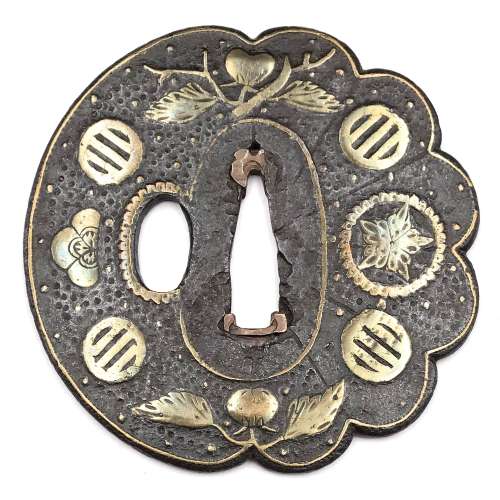 Iron tsuba of half round and half lobed (chrysanthemoid) form decorated with plants and family crests (mon) in cast brass inlay (suemon-zōgan), and scattered brass dots inlay (ten-zōgan); brass wire inlay outlining the rim, seppa-dai, and hitsu-ana (scalloped wire) on both sides. Surface treated with hummer punch marks. The chrysanthemoid half of the plate chiseled with thin shallow grooves, outlining the petals. Copper sekigane. On the face the inlay represents: mandarin orange (tachibana), half karahana, encircled bellflower, and four encircled three-stipe family crest (mitsubiki-mon of Sakuma and Abe clans, and some others). On the reverse the design is similar but two of the mitsubiki-mon symbols replaced with two comb-shaped Genji-mon ideographs. Ōnin school. The end of mid-Muromachi period, beginning of the 16th century. Size: 74.3 x 72.7 x 2.4 mm.
Iron tsuba of half round and half lobed (chrysanthemoid) form decorated with plants and family crests (mon) in cast brass inlay (suemon-zōgan), and scattered brass dots inlay (ten-zōgan); brass wire inlay outlining the rim, seppa-dai, and hitsu-ana (scalloped wire) on both sides. Surface treated with hummer punch marks. The chrysanthemoid half of the plate chiseled with thin shallow grooves, outlining the petals. Copper sekigane. On the face the inlay represents: mandarin orange (tachibana), half karahana, encircled bellflower, and four encircled three-stipe family crest (mitsubiki-mon of Sakuma and Abe clans, and some others). On the reverse the design is similar but two of the mitsubiki-mon symbols replaced with two comb-shaped Genji-mon ideographs. Ōnin school. The end of mid-Muromachi period, beginning of the 16th century. Size: 74.3 x 72.7 x 2.4 mm. -
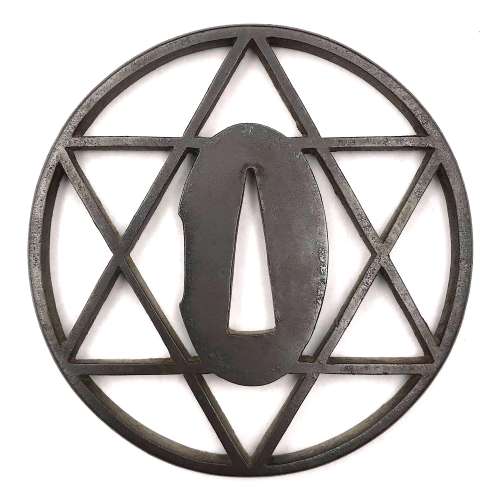 Iron tsuba of round form with two overlapping triangles (uroko) motif in openwork (sukashi). Triangle patterns usually associate with 'fish scale', mon of Hojo family (and others). Edo period or later.
Iron tsuba of round form with two overlapping triangles (uroko) motif in openwork (sukashi). Triangle patterns usually associate with 'fish scale', mon of Hojo family (and others). Edo period or later.Size: 71.4 x 70.2 x 5.2 mm.
An association with the Star of David is doubtful if not impossible. -
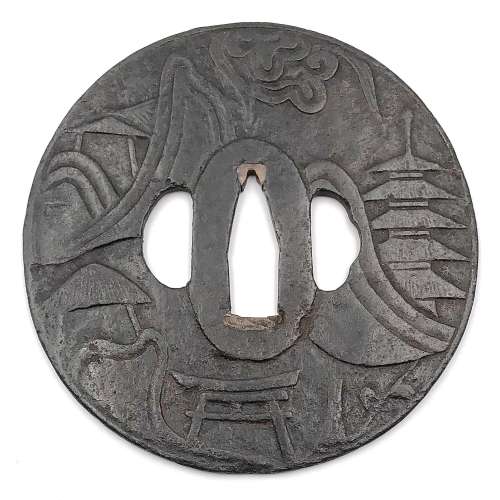
Thin iron plate of round form and black color carved in sukidashi-bori with design of rocks, waves, clouds, temple gates (torii), mountain pavilion and 5-storey pagoda on both sides, alluding to Todai-ji temple in Nara. Hitsu-ana pierced later. Very narrow very slightly raised rim. Copper sekigane.
Late Muromachi period, 16th century. Dimensions: 88.7 x 88.0 x 2.4 mm (seppa-dai), 1.8 mm (base plate).Reference: “Art of the Samurai” on page 232, №140: ”Kamakura tsuba with Sangatsu-do tower and bridge. Muromachi period, 16th century. 83 mm x 80 mm. Unsigned. Tokyo National Museum. The mountain pavilion and bridge carved in sunken relief on the iron tsuba – both part of Tōdai-ji, a temple in Nara – are detailed in fine kebori (line) engraving. As a result of the chiseling used to create the relief, the ground of the piece is relatively thin".
-
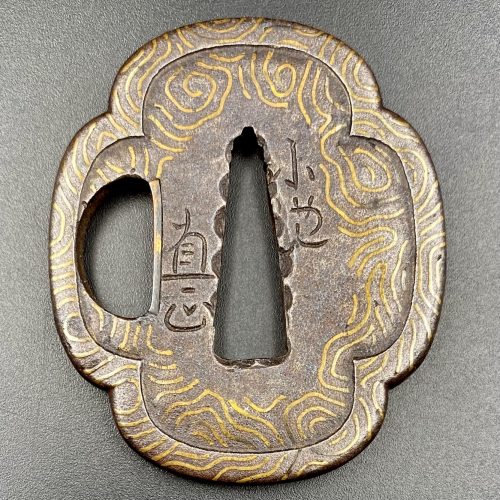
Small iron tsuba for a dagger (tantō), of quatrefoil form (mokkō-gata), with raised rim (mimi), decorated with flat brass inlay (hira-zōgan) to form an abstract design alluding to the mushroom of immortality (reishi). Opening (hitsu-ana) to the left of nakaga-ana probably cut later and fitted with shakudo sekigane. Maker's signature on seppa-dai: Koike Naomasa (小池 直正).
Momoyama period: End of the 16th - beginning of the 17th century. Dimensions: Height 53.7 mm; Width: 45.5 mm; Thickness at centre: 3.5 mm; at rim: 4.9 mm. Other examples of signed Koike Naomasa work in this collection: TSU-0346. Reference: The closest example in literature is in Compton Collection (II): №11 with the description: “A Koike School tsuba, Edo period (circa 1625), signed Koike Yoshiro. Sheet-brass flush inlay of cloud forms and wire inlay creating the same shape. Koike Yoshiro Naomasa worked from the Keicho to the Genna periods (1596-1623). He arrived in Kyoto from Kaga.” [Japanese Swords and Sword Fittings from the Collection of Dr. Walter Ames Compton (Part II) / Sebastian Izzard, Yoshinori Munemura. — Christie's, New York, October 22, 1992]. See: Yoshirō tsuba.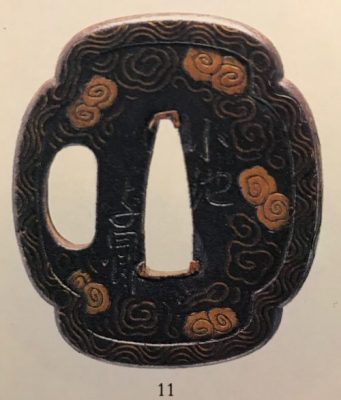
-
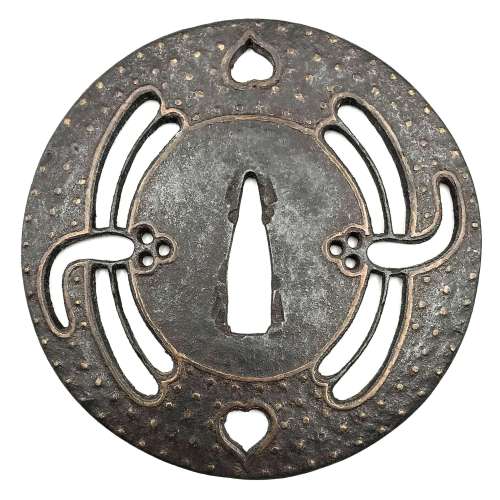 Iron tsuba of round form decorated with two boar's eyes (inome) and two dragonflies (tombo) in small openwork (ko-sukashi) outlined with brass wire. The plate also decorated with 2 to 5 concentric circular rows of brass dots (nail heads) in ten-zōgan. Center of the plate outlined with the inlaid circular brass wire. The inlaid metal is of red-ish hue, so it may be copper, and not brass. The surface has remnants of lacquer. Ōnin school. Mid Muromachi period, middle of 15th century. Dimensions: Diameter: 90 mm, thickness: 3.2 mm. Notes regarding design: "According to various sources, the dragonfly (tombo) is emblematic of martial success, as various names for the insect are homophones for words meaning "victory". The dragonfly is also auspicious because references in the Kojiki and Nihongi link it in both name and shape to the old kingdom of Yamato." [Merrily Baird. Symbols of Japan. Thematic motifs in art and design. Rizzoli international publications, Inc., 2001, p. 108]. "The dragonfly (tonbo), was also called kachimushi in earlier times, and due to the auspicious literal meaning "victory bug" of the characters of this word it became a popular theme on sword fittings." [Iron tsuba. The works of the exhibition "Kurogane no hana", The Japanese Sword Museum, 2014, p. 13]. Two other cutouts - in the form of what in European tradition symbolizes the heart, on the top and in the bottom of tsuba disc - may have two different explanations. The most usual one, inome - "Heart-shaped pattern, which is said to go back to the shape of a wild boar's eye" [Markus Sesko. Encyclopedia of Japanese Swords. Print and publishing: Lulu Enterprises, Inc., 2014.]. This understanding is shared by Robert Haynes [Robert E. Haynes. Study Collection of Japanese Sword Fittings. Nihon Art Publishers, 2010.] and elsewhere, with an exception of Okabe-Kakuya [Okabe-Kakuya. JAPANESE SWORD GUARDS. Museum of Fine Arts, Boston. In cooperation with the department of Chinese and Japanese art; - 1908, p. 14], who provides the illustration of inome-shaped cut-outs with the following explanation: " The tsuba shown in Fig. 13 approaches a square form with rounded corners and is perforated with Aoi decoration. But this book was written long time ago, when people even at MFA might not know enough...
Iron tsuba of round form decorated with two boar's eyes (inome) and two dragonflies (tombo) in small openwork (ko-sukashi) outlined with brass wire. The plate also decorated with 2 to 5 concentric circular rows of brass dots (nail heads) in ten-zōgan. Center of the plate outlined with the inlaid circular brass wire. The inlaid metal is of red-ish hue, so it may be copper, and not brass. The surface has remnants of lacquer. Ōnin school. Mid Muromachi period, middle of 15th century. Dimensions: Diameter: 90 mm, thickness: 3.2 mm. Notes regarding design: "According to various sources, the dragonfly (tombo) is emblematic of martial success, as various names for the insect are homophones for words meaning "victory". The dragonfly is also auspicious because references in the Kojiki and Nihongi link it in both name and shape to the old kingdom of Yamato." [Merrily Baird. Symbols of Japan. Thematic motifs in art and design. Rizzoli international publications, Inc., 2001, p. 108]. "The dragonfly (tonbo), was also called kachimushi in earlier times, and due to the auspicious literal meaning "victory bug" of the characters of this word it became a popular theme on sword fittings." [Iron tsuba. The works of the exhibition "Kurogane no hana", The Japanese Sword Museum, 2014, p. 13]. Two other cutouts - in the form of what in European tradition symbolizes the heart, on the top and in the bottom of tsuba disc - may have two different explanations. The most usual one, inome - "Heart-shaped pattern, which is said to go back to the shape of a wild boar's eye" [Markus Sesko. Encyclopedia of Japanese Swords. Print and publishing: Lulu Enterprises, Inc., 2014.]. This understanding is shared by Robert Haynes [Robert E. Haynes. Study Collection of Japanese Sword Fittings. Nihon Art Publishers, 2010.] and elsewhere, with an exception of Okabe-Kakuya [Okabe-Kakuya. JAPANESE SWORD GUARDS. Museum of Fine Arts, Boston. In cooperation with the department of Chinese and Japanese art; - 1908, p. 14], who provides the illustration of inome-shaped cut-outs with the following explanation: " The tsuba shown in Fig. 13 approaches a square form with rounded corners and is perforated with Aoi decoration. But this book was written long time ago, when people even at MFA might not know enough... The same interpretation of the said heart-like symbol (aoi leaf) is given at Helen C. Gunsaulus. Japanese sword-mounts in the collection of Field Museum. // Publication 216, Anthropological Series, Volume XVI; Chicago, 1923; p. 54: "This mokkō-formed tsuba recalls the aoi form, perforated as it is with the four aoi leaves." It is possible that the "wild boar's eye" theory was developed by later scholars.
The same interpretation of the said heart-like symbol (aoi leaf) is given at Helen C. Gunsaulus. Japanese sword-mounts in the collection of Field Museum. // Publication 216, Anthropological Series, Volume XVI; Chicago, 1923; p. 54: "This mokkō-formed tsuba recalls the aoi form, perforated as it is with the four aoi leaves." It is possible that the "wild boar's eye" theory was developed by later scholars.
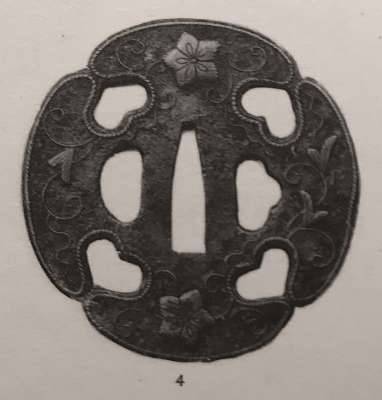 There is also a theory, supported by Graham Gemmell, saying that: “In simple terms Onin works are decorated Ko-Katchushi tsuba. … But, not content with iron alone, they began to decorate it with what was, in the early Muromachi period, a rare and valuable metal, brass. The Onin workers cut the design into the iron, using narrow channels, cast the brass, piece by piece, and then hammered it into the iron plate as though they were putting together a jigsaw. When complete the tsuba would be black lacquered exactly as the plain iron ones had been, the brass shining dully through it in a way that fulfilled the goal of shibui or restrained elegance.” [Tosogu. Treasure of the samurai. Fine Japanese Sword Fittings from The Muromachi to The Meiji Period, by Graham Gemmell. // Sarzi-Amadè Limited, London, 1991. An exhibition held in London from 21st March to 4th April, 1991]. The following illustration from Helen C. Gunsaulus. Japanese sword-mounts in the collection of Field Museum. // Publication 216, Anthropological Series, Volume XVI; Chicago, 1923; pp. 43 supports the idea.
There is also a theory, supported by Graham Gemmell, saying that: “In simple terms Onin works are decorated Ko-Katchushi tsuba. … But, not content with iron alone, they began to decorate it with what was, in the early Muromachi period, a rare and valuable metal, brass. The Onin workers cut the design into the iron, using narrow channels, cast the brass, piece by piece, and then hammered it into the iron plate as though they were putting together a jigsaw. When complete the tsuba would be black lacquered exactly as the plain iron ones had been, the brass shining dully through it in a way that fulfilled the goal of shibui or restrained elegance.” [Tosogu. Treasure of the samurai. Fine Japanese Sword Fittings from The Muromachi to The Meiji Period, by Graham Gemmell. // Sarzi-Amadè Limited, London, 1991. An exhibition held in London from 21st March to 4th April, 1991]. The following illustration from Helen C. Gunsaulus. Japanese sword-mounts in the collection of Field Museum. // Publication 216, Anthropological Series, Volume XVI; Chicago, 1923; pp. 43 supports the idea.
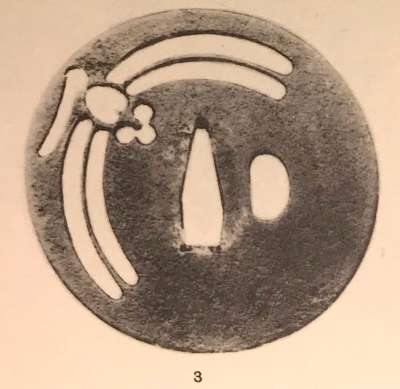 Helen C. Gunsaulus' description of the dragonfly emblem is as follows: "This motive, the dragon-fly (akitsu), is generally accepted as a symbol of the kingdom of Japan, and the origin of the idea is traced to the legend recounted in the Kojiki and Nihongo of the Emperor Jimmu's view of the island from mountain top. He is said to have thought the kingdom looked like a dragon-fly touching its tail with its mouth. From this it received its name Akitsu-shima... etc."
Helen C. Gunsaulus' description of the dragonfly emblem is as follows: "This motive, the dragon-fly (akitsu), is generally accepted as a symbol of the kingdom of Japan, and the origin of the idea is traced to the legend recounted in the Kojiki and Nihongo of the Emperor Jimmu's view of the island from mountain top. He is said to have thought the kingdom looked like a dragon-fly touching its tail with its mouth. From this it received its name Akitsu-shima... etc."
-
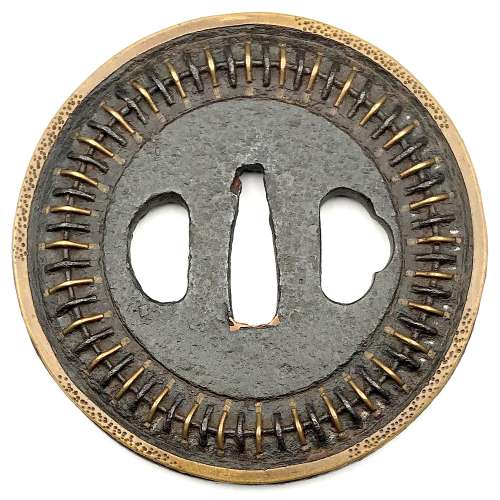 Iron tsuba of round form with circular iron wire fastened to the surface with iron and brass staples (mukade-zōgan); brass ring about 2.5 mm wide along the rim with chisel marks. Design repeats on the reverse. Copper sekigane. Early Edo, 17th century. Size: Height: 83.3 mm; width 83.9 mm; thickness at seppa-dai: 4.5 mm. Weight 173.6 g. Design is thought to resemble a centipede. "Centipede-like inlay (mukade zogan) of alternating iron and brass staples produce an appearance that was particularly favored by Takeda Shingen (1521-1573), one of the most powerful warlords of his time. The centipede is sacred to Bishamon (God of War) and especially propitious for a warrior. Shingen type, 16th century.” [The Peabody Museum collection of Japanese sword guards with selected pieces of sword furniture, by John D. Hamilton. Photographs by Mark Sexton. Salem, MA, 1975.] See also: http://varshavskycollection.com/shingen-tsuba/ SOLD
Iron tsuba of round form with circular iron wire fastened to the surface with iron and brass staples (mukade-zōgan); brass ring about 2.5 mm wide along the rim with chisel marks. Design repeats on the reverse. Copper sekigane. Early Edo, 17th century. Size: Height: 83.3 mm; width 83.9 mm; thickness at seppa-dai: 4.5 mm. Weight 173.6 g. Design is thought to resemble a centipede. "Centipede-like inlay (mukade zogan) of alternating iron and brass staples produce an appearance that was particularly favored by Takeda Shingen (1521-1573), one of the most powerful warlords of his time. The centipede is sacred to Bishamon (God of War) and especially propitious for a warrior. Shingen type, 16th century.” [The Peabody Museum collection of Japanese sword guards with selected pieces of sword furniture, by John D. Hamilton. Photographs by Mark Sexton. Salem, MA, 1975.] See also: http://varshavskycollection.com/shingen-tsuba/ SOLD -
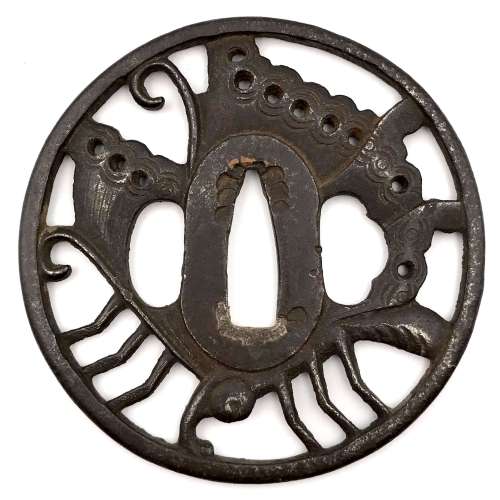 Iron tsuba of round form decorated with the design of a butterfly in openwork (sukashi) with details carved in kebori. Eyes inlaid in brass (one inlay is missing). Unsigned. Attributed to Bizen Shōami school, early Edo period (17th century). Dimensions: 80.4 x 80.6 x 4.4 mm References At Haynes Catalog #6, p. 18-19, Lot 30: "Famous Ikeda butterfly design" (Ikeda family of Inaba and Okayama, and at least 7 other families). Ca. 1700. Shōami of Kyoto, no doubt. Ht 8.2 cm, Th. 5 mm. ["Important tsuba, menuki, bokuto, woodblock prints, koshirae, sword pistol and kana mono". San Francisco, June 1-26, 1983. Catalog #6. Robert E. Haynes, Ltd.]Similar tsuba at Haynes Catalog #9, p.71, lot 143: the classic Shoami tsuba of the mon of the Ikeda family. This example, as most, seems to be made by the same hand as the others. See Haynes sale number 6, lot 30, for an identical example. The eye is brass. From an old French collection. Ht. 7.9 cm., Th. 5 mm.
Iron tsuba of round form decorated with the design of a butterfly in openwork (sukashi) with details carved in kebori. Eyes inlaid in brass (one inlay is missing). Unsigned. Attributed to Bizen Shōami school, early Edo period (17th century). Dimensions: 80.4 x 80.6 x 4.4 mm References At Haynes Catalog #6, p. 18-19, Lot 30: "Famous Ikeda butterfly design" (Ikeda family of Inaba and Okayama, and at least 7 other families). Ca. 1700. Shōami of Kyoto, no doubt. Ht 8.2 cm, Th. 5 mm. ["Important tsuba, menuki, bokuto, woodblock prints, koshirae, sword pistol and kana mono". San Francisco, June 1-26, 1983. Catalog #6. Robert E. Haynes, Ltd.]Similar tsuba at Haynes Catalog #9, p.71, lot 143: the classic Shoami tsuba of the mon of the Ikeda family. This example, as most, seems to be made by the same hand as the others. See Haynes sale number 6, lot 30, for an identical example. The eye is brass. From an old French collection. Ht. 7.9 cm., Th. 5 mm.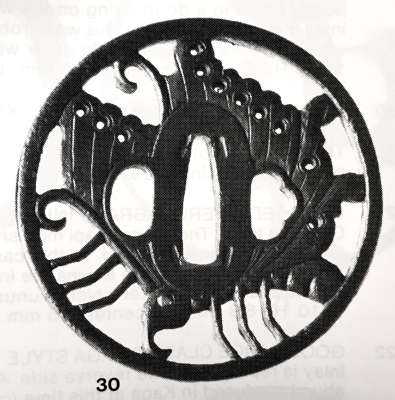
Haynes Catalog #6, lot 30.
Similar tsuba in the Randolph B. Caldwell Collection, 1994, page 24, №13: "A circular iron tsuba pierced in positive sukashi with a butterfly within an angular rim, details engraved. The eye inlaid in brass [in my specimen the inlay is missing on the omote side]. Unsigned. Bizen Shōami, Momoyama period. Dimensions: 8.0 x 8.2 x 0.5 cm. Similar example: Durand-Ruel, collection Ch. Gilloz, number 1302. [SV: that's possibly the 'old French collection' of Robert Haynes.]
Haynes Catalog #9, lot 143.
If we accept Haynes' theory regarding the genealogy and history of Bizen Shōami family, Momoyama period attribution would seem unlikely. I am leaning towards the early to mid 17th century.
Caldwell Collection, #13.
-
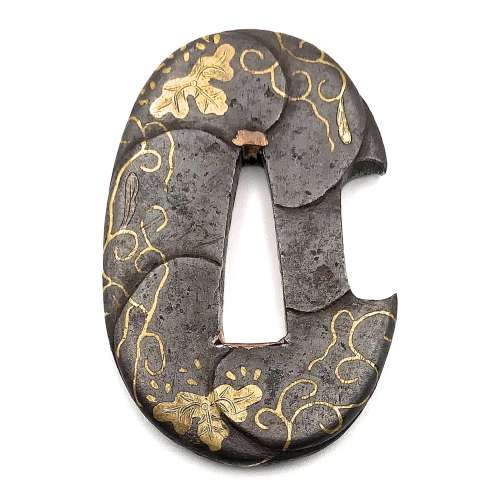
Small iron tsuba (tantō size) of oval form carved with imitation of six overlapping plates, decorated with paulownia blossoms, leaves, and tendrils in brass and copper hira-zōgan. Copper sekigane. Open kozuka hitsu-ana.
Early Edo period, 17th century.
Size: 50.5 x 34.0 x 4.9 mm.
-
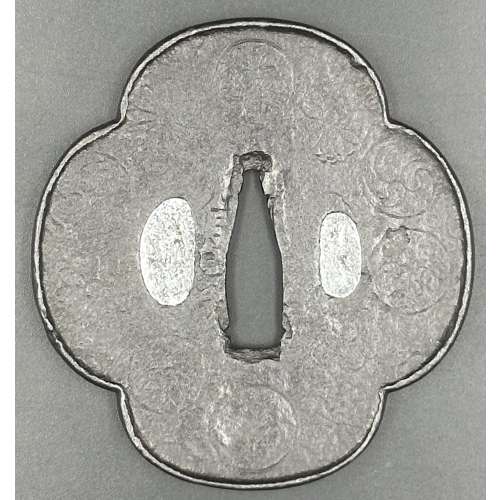 Iron tsuba of mokko form decorated with encircled family crests in low relief carving; niku from 3.0 mm in the centre to 4.0 mm at rim and full 1 mm raised uchikaeshi-mimi. Nobuie [信家] signature (hanare-mei) to the left of nakago-ana; on the reverse, to the right of nakago-ana, the inscription reads “62”, which may be how old the master was at the age of making the tsuba. Pewter or lead plugged hitsuana. In a wooden box, in a custom pouch. Size: H: 80 mm, W: 75, Th(c): 3.1 mm, Th(r): 4.0 mm Weight: 103.5 g
Iron tsuba of mokko form decorated with encircled family crests in low relief carving; niku from 3.0 mm in the centre to 4.0 mm at rim and full 1 mm raised uchikaeshi-mimi. Nobuie [信家] signature (hanare-mei) to the left of nakago-ana; on the reverse, to the right of nakago-ana, the inscription reads “62”, which may be how old the master was at the age of making the tsuba. Pewter or lead plugged hitsuana. In a wooden box, in a custom pouch. Size: H: 80 mm, W: 75, Th(c): 3.1 mm, Th(r): 4.0 mm Weight: 103.5 gSigned: Nobuie [信家] / 62
Probably the work of Shodai Nobuie (c. 1580).
Tokubetsu hozon certificate № 2002993 of the N.B.T.H.K., dated January 15, 2016. NOBUIE TSUBA by Steve Waszak The iron tsuba made by the two early Nobuie masters are regarded as the greatest sword guards ever made across hundreds of years of Japanese history. Only a small handful of other smiths' names are even mentioned in the same breath as that of Nobuie. Despite the well-deserved fame of the Nobuie name, virtually nothing is known with certainty about the lives of the two men who made the pieces carrying this name. They are thought to have been men of Owari Province, with the Nidai Nobuie also spending time in Aki Province at the end of the Momoyama Period. Two Nobuie tsubako are recognized. The man whom most consider to have been the Shodai signed his sword guards with finer and more elegantly inscribed characters than the smith seen by most as the Nidai. The term used to describe the mei of the Shodai is "hanare-mei" or "ga-mei," while that used to characterize the signature of the Nidai is "futoji-mei" or "chikara-mei." These terms refer to the fineness and grace of the Shodai's signature and the relatively more powerfully inscribed characters of the Nidai's. The Shodai is thought to have lived during the Eiroku and Tensho eras in the latter part of the 16th century, while the Nidai's years are considered to have been from Tensho into the Genna era. This locates both smiths well within the Golden Age of tsuba artists -- the Momoyama Period. Nobuie tsuba are esteemed and celebrated for the extraordinary beauty of their iron. The combination of the forging of the metal, the surface treatment by tsuchime and yakite married to powerfully expressive carving, the masterful manipulation of form, mass and shape, and the colour and patina of the iron makes Nobuie sword guards not only unique in the world of tsuba, but the greatest of the great. The sword guard here is a Shodai-made masterwork, done in mokko-gata form, a shape the early Nobuie smiths mastered to a degree unmatched by any others. The expanding of the mass of the tsuba from the seppa-dai to the mimi, increasing by 50% from the centre of the guard to the rim, creates a sense of exploding energy, which is then contained by the uchikaeshi-mimi, yielding a lightning-in-a-bottle effect of captured energy. The hammering the master has employed to finish the surface is subtle and sensitive, achieving a resonant profundity, and the deep blue-black colour -- augmented by a lustrous patina -- leaves the tsuba to positively glow in one's hand. In this piece, Nobuie has used a motif of several kamon, or family crests, each carved only lightly on the surface in a loose ring around the nakago-ana. Due to the shallow depth of this carving, together with the tsuchime finish of the plate, the effect is to leave the kamon with a sort of weathered appearance, recalling the prime aesthetic values of sabi and wabi, which had great circulation in the Tea Culture so ascendant in the Momoyama years. However, the effects of sabi and wabi expressed in the treatment described above are amplified and deepened by the color and patina of the iron, thereby adding yet another aesthetic value -- yuugen -- which is linked with the abiding mystery of the universe and one more — mono no aware — which alludes to the pathos of life's experiences and transitory nature. In short, this Nobuie tsuba joins poetry with power and therein exemplifies the unrivalled brilliance of Nobuie workmanship. -
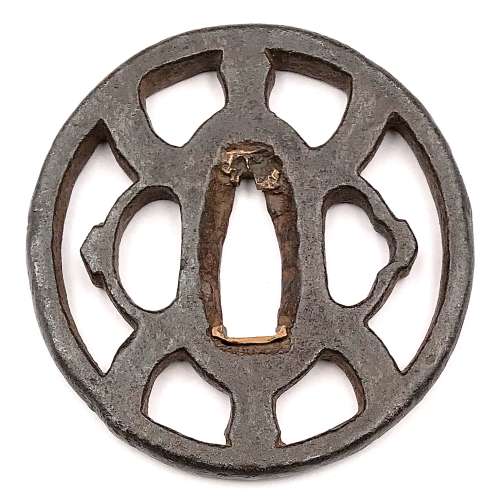 Iron tsuba of round form with design of the Chinese character for cinnabar (shu-no-ji) in openwork (sukashi). Round-cornered rim. Copper sekigane. Kanayama school. Early Edo period: Early 17th century (Kan-ei era). Height: 70.0 mm. Width: 69.6 mm. Rim thickness: 6.8 mm. Center thickness: 5.8 mm. Provenance: Sasano Masayuki Collection, № 139: "Many areas have a coarse texture and strong tekkotsu, with the thickness of the metal graduating from the rim to the seppa-dai. The combined color of the iron and motif date this work to the early Edo period".
Iron tsuba of round form with design of the Chinese character for cinnabar (shu-no-ji) in openwork (sukashi). Round-cornered rim. Copper sekigane. Kanayama school. Early Edo period: Early 17th century (Kan-ei era). Height: 70.0 mm. Width: 69.6 mm. Rim thickness: 6.8 mm. Center thickness: 5.8 mm. Provenance: Sasano Masayuki Collection, № 139: "Many areas have a coarse texture and strong tekkotsu, with the thickness of the metal graduating from the rim to the seppa-dai. The combined color of the iron and motif date this work to the early Edo period".


